Evaluating Financial Projects: NPV, IRR, YTM, and Monetary Policy
VerifiedAdded on 2023/06/13
|14
|4322
|255
Report
AI Summary
This report provides a comprehensive analysis of various financial concepts and tools. It begins with a calculation of Net Present Value (NPV) and Internal Rate of Return (IRR) for a given project, offering a recommendation based on these metrics. The report then explains how Yield to Maturity (YTM) is used to calculate the Yield Curve, followed by an analysis of the importance of financial intermediaries in a well-functioning financial system, discussing their advantages and disadvantages. Finally, it explores the factors that determine the time-lag between the application of monetary policy instruments and the achievement of ultimate goals. The report utilizes calculations, definitions, and examples to illustrate these key financial principles.

Money banking and
finance
finance
Paraphrase This Document
Need a fresh take? Get an instant paraphrase of this document with our AI Paraphraser
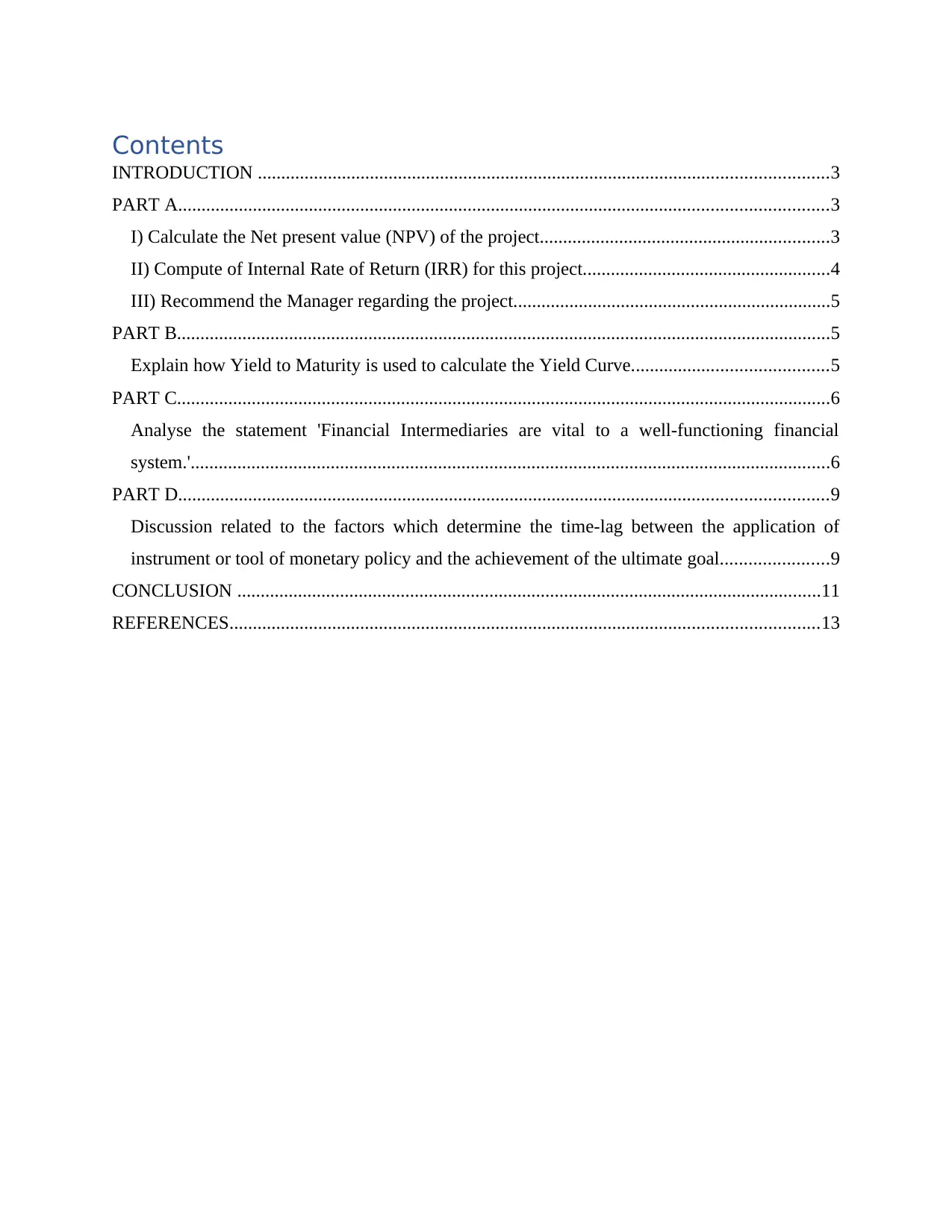
Contents
INTRODUCTION ..........................................................................................................................3
PART A...........................................................................................................................................3
I) Calculate the Net present value (NPV) of the project..............................................................3
II) Compute of Internal Rate of Return (IRR) for this project.....................................................4
III) Recommend the Manager regarding the project....................................................................5
PART B............................................................................................................................................5
Explain how Yield to Maturity is used to calculate the Yield Curve..........................................5
PART C............................................................................................................................................6
Analyse the statement 'Financial Intermediaries are vital to a well-functioning financial
system.'.........................................................................................................................................6
PART D...........................................................................................................................................9
Discussion related to the factors which determine the time-lag between the application of
instrument or tool of monetary policy and the achievement of the ultimate goal.......................9
CONCLUSION .............................................................................................................................11
REFERENCES..............................................................................................................................13
INTRODUCTION ..........................................................................................................................3
PART A...........................................................................................................................................3
I) Calculate the Net present value (NPV) of the project..............................................................3
II) Compute of Internal Rate of Return (IRR) for this project.....................................................4
III) Recommend the Manager regarding the project....................................................................5
PART B............................................................................................................................................5
Explain how Yield to Maturity is used to calculate the Yield Curve..........................................5
PART C............................................................................................................................................6
Analyse the statement 'Financial Intermediaries are vital to a well-functioning financial
system.'.........................................................................................................................................6
PART D...........................................................................................................................................9
Discussion related to the factors which determine the time-lag between the application of
instrument or tool of monetary policy and the achievement of the ultimate goal.......................9
CONCLUSION .............................................................................................................................11
REFERENCES..............................................................................................................................13
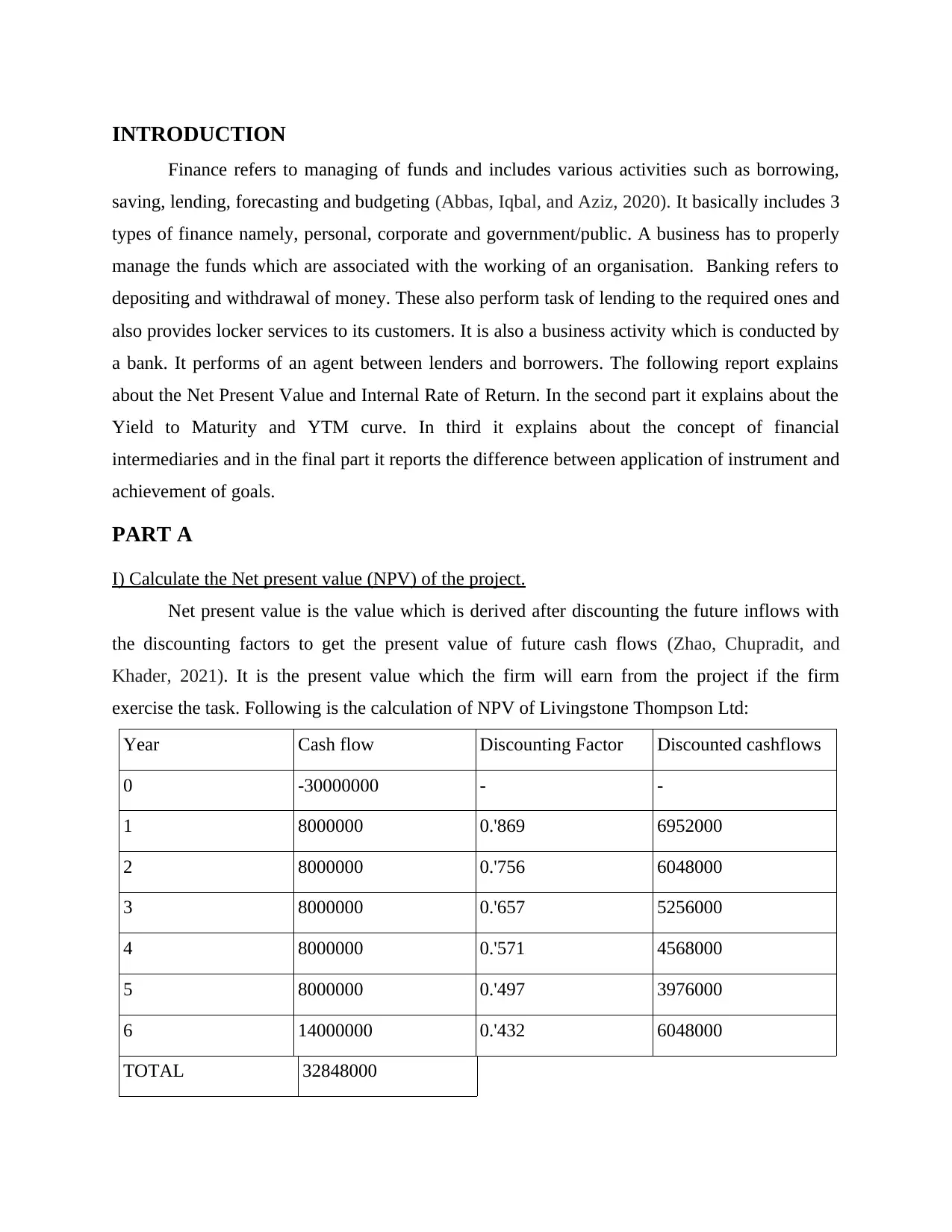
INTRODUCTION
Finance refers to managing of funds and includes various activities such as borrowing,
saving, lending, forecasting and budgeting (Abbas, Iqbal, and Aziz, 2020). It basically includes 3
types of finance namely, personal, corporate and government/public. A business has to properly
manage the funds which are associated with the working of an organisation. Banking refers to
depositing and withdrawal of money. These also perform task of lending to the required ones and
also provides locker services to its customers. It is also a business activity which is conducted by
a bank. It performs of an agent between lenders and borrowers. The following report explains
about the Net Present Value and Internal Rate of Return. In the second part it explains about the
Yield to Maturity and YTM curve. In third it explains about the concept of financial
intermediaries and in the final part it reports the difference between application of instrument and
achievement of goals.
PART A
I) Calculate the Net present value (NPV) of the project.
Net present value is the value which is derived after discounting the future inflows with
the discounting factors to get the present value of future cash flows (Zhao, Chupradit, and
Khader, 2021). It is the present value which the firm will earn from the project if the firm
exercise the task. Following is the calculation of NPV of Livingstone Thompson Ltd:
Year Cash flow Discounting Factor Discounted cashflows
0 -30000000 - -
1 8000000 0.'869 6952000
2 8000000 0.'756 6048000
3 8000000 0.'657 5256000
4 8000000 0.'571 4568000
5 8000000 0.'497 3976000
6 14000000 0.'432 6048000
TOTAL 32848000
Finance refers to managing of funds and includes various activities such as borrowing,
saving, lending, forecasting and budgeting (Abbas, Iqbal, and Aziz, 2020). It basically includes 3
types of finance namely, personal, corporate and government/public. A business has to properly
manage the funds which are associated with the working of an organisation. Banking refers to
depositing and withdrawal of money. These also perform task of lending to the required ones and
also provides locker services to its customers. It is also a business activity which is conducted by
a bank. It performs of an agent between lenders and borrowers. The following report explains
about the Net Present Value and Internal Rate of Return. In the second part it explains about the
Yield to Maturity and YTM curve. In third it explains about the concept of financial
intermediaries and in the final part it reports the difference between application of instrument and
achievement of goals.
PART A
I) Calculate the Net present value (NPV) of the project.
Net present value is the value which is derived after discounting the future inflows with
the discounting factors to get the present value of future cash flows (Zhao, Chupradit, and
Khader, 2021). It is the present value which the firm will earn from the project if the firm
exercise the task. Following is the calculation of NPV of Livingstone Thompson Ltd:
Year Cash flow Discounting Factor Discounted cashflows
0 -30000000 - -
1 8000000 0.'869 6952000
2 8000000 0.'756 6048000
3 8000000 0.'657 5256000
4 8000000 0.'571 4568000
5 8000000 0.'497 3976000
6 14000000 0.'432 6048000
TOTAL 32848000
⊘ This is a preview!⊘
Do you want full access?
Subscribe today to unlock all pages.

Trusted by 1+ million students worldwide
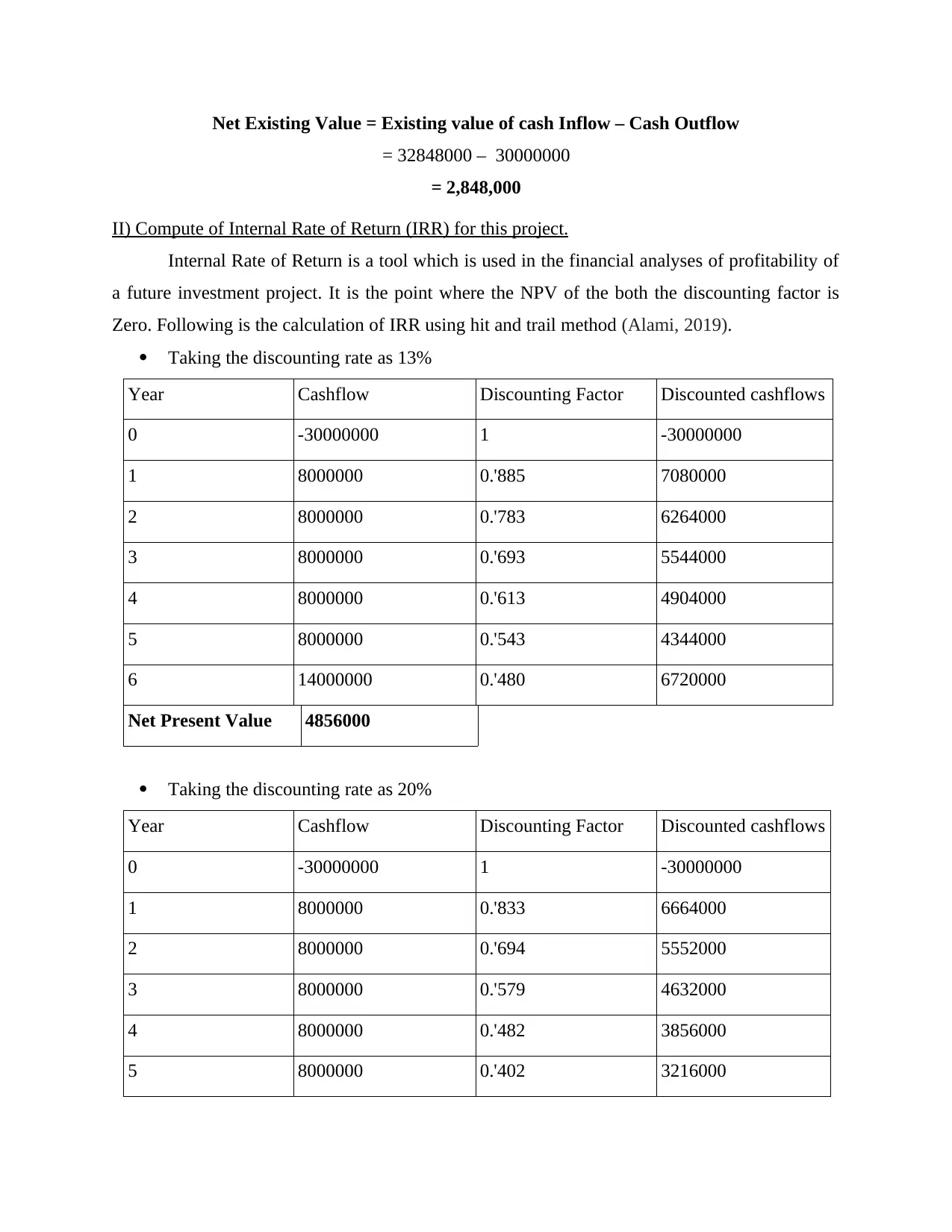
Net Existing Value = Existing value of cash Inflow – Cash Outflow
= 32848000 – 30000000
= 2,848,000
II) Compute of Internal Rate of Return (IRR) for this project.
Internal Rate of Return is a tool which is used in the financial analyses of profitability of
a future investment project. It is the point where the NPV of the both the discounting factor is
Zero. Following is the calculation of IRR using hit and trail method (Alami, 2019).
Taking the discounting rate as 13%
Year Cashflow Discounting Factor Discounted cashflows
0 -30000000 1 -30000000
1 8000000 0.'885 7080000
2 8000000 0.'783 6264000
3 8000000 0.'693 5544000
4 8000000 0.'613 4904000
5 8000000 0.'543 4344000
6 14000000 0.'480 6720000
Net Present Value 4856000
Taking the discounting rate as 20%
Year Cashflow Discounting Factor Discounted cashflows
0 -30000000 1 -30000000
1 8000000 0.'833 6664000
2 8000000 0.'694 5552000
3 8000000 0.'579 4632000
4 8000000 0.'482 3856000
5 8000000 0.'402 3216000
= 32848000 – 30000000
= 2,848,000
II) Compute of Internal Rate of Return (IRR) for this project.
Internal Rate of Return is a tool which is used in the financial analyses of profitability of
a future investment project. It is the point where the NPV of the both the discounting factor is
Zero. Following is the calculation of IRR using hit and trail method (Alami, 2019).
Taking the discounting rate as 13%
Year Cashflow Discounting Factor Discounted cashflows
0 -30000000 1 -30000000
1 8000000 0.'885 7080000
2 8000000 0.'783 6264000
3 8000000 0.'693 5544000
4 8000000 0.'613 4904000
5 8000000 0.'543 4344000
6 14000000 0.'480 6720000
Net Present Value 4856000
Taking the discounting rate as 20%
Year Cashflow Discounting Factor Discounted cashflows
0 -30000000 1 -30000000
1 8000000 0.'833 6664000
2 8000000 0.'694 5552000
3 8000000 0.'579 4632000
4 8000000 0.'482 3856000
5 8000000 0.'402 3216000
Paraphrase This Document
Need a fresh take? Get an instant paraphrase of this document with our AI Paraphraser
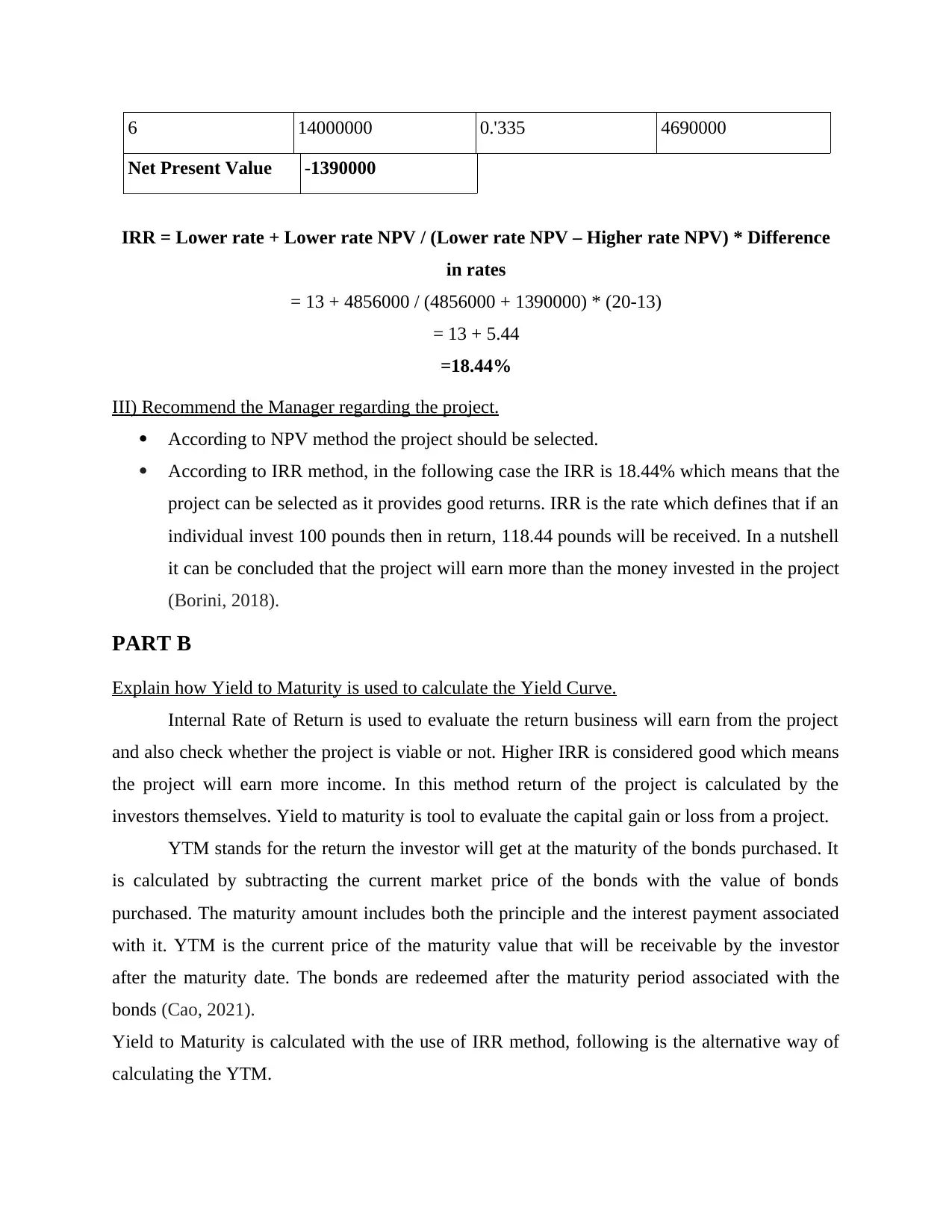
6 14000000 0.'335 4690000
Net Present Value -1390000
IRR = Lower rate + Lower rate NPV / (Lower rate NPV – Higher rate NPV) * Difference
in rates
= 13 + 4856000 / (4856000 + 1390000) * (20-13)
= 13 + 5.44
=18.44%
III) Recommend the Manager regarding the project.
According to NPV method the project should be selected.
According to IRR method, in the following case the IRR is 18.44% which means that the
project can be selected as it provides good returns. IRR is the rate which defines that if an
individual invest 100 pounds then in return, 118.44 pounds will be received. In a nutshell
it can be concluded that the project will earn more than the money invested in the project
(Borini, 2018).
PART B
Explain how Yield to Maturity is used to calculate the Yield Curve.
Internal Rate of Return is used to evaluate the return business will earn from the project
and also check whether the project is viable or not. Higher IRR is considered good which means
the project will earn more income. In this method return of the project is calculated by the
investors themselves. Yield to maturity is tool to evaluate the capital gain or loss from a project.
YTM stands for the return the investor will get at the maturity of the bonds purchased. It
is calculated by subtracting the current market price of the bonds with the value of bonds
purchased. The maturity amount includes both the principle and the interest payment associated
with it. YTM is the current price of the maturity value that will be receivable by the investor
after the maturity date. The bonds are redeemed after the maturity period associated with the
bonds (Cao, 2021).
Yield to Maturity is calculated with the use of IRR method, following is the alternative way of
calculating the YTM.
Net Present Value -1390000
IRR = Lower rate + Lower rate NPV / (Lower rate NPV – Higher rate NPV) * Difference
in rates
= 13 + 4856000 / (4856000 + 1390000) * (20-13)
= 13 + 5.44
=18.44%
III) Recommend the Manager regarding the project.
According to NPV method the project should be selected.
According to IRR method, in the following case the IRR is 18.44% which means that the
project can be selected as it provides good returns. IRR is the rate which defines that if an
individual invest 100 pounds then in return, 118.44 pounds will be received. In a nutshell
it can be concluded that the project will earn more than the money invested in the project
(Borini, 2018).
PART B
Explain how Yield to Maturity is used to calculate the Yield Curve.
Internal Rate of Return is used to evaluate the return business will earn from the project
and also check whether the project is viable or not. Higher IRR is considered good which means
the project will earn more income. In this method return of the project is calculated by the
investors themselves. Yield to maturity is tool to evaluate the capital gain or loss from a project.
YTM stands for the return the investor will get at the maturity of the bonds purchased. It
is calculated by subtracting the current market price of the bonds with the value of bonds
purchased. The maturity amount includes both the principle and the interest payment associated
with it. YTM is the current price of the maturity value that will be receivable by the investor
after the maturity date. The bonds are redeemed after the maturity period associated with the
bonds (Cao, 2021).
Yield to Maturity is calculated with the use of IRR method, following is the alternative way of
calculating the YTM.
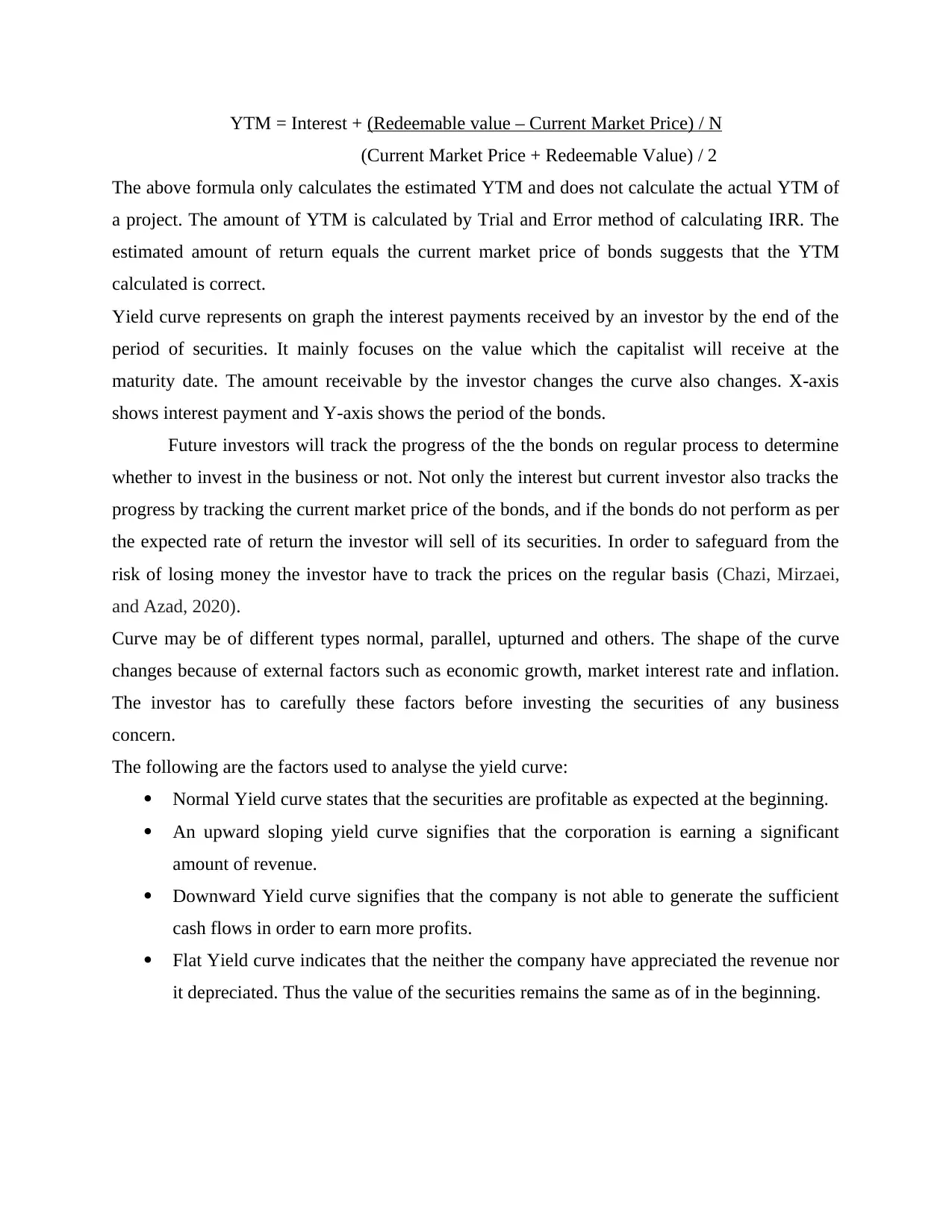
YTM = Interest + (Redeemable value – Current Market Price) / N
(Current Market Price + Redeemable Value) / 2
The above formula only calculates the estimated YTM and does not calculate the actual YTM of
a project. The amount of YTM is calculated by Trial and Error method of calculating IRR. The
estimated amount of return equals the current market price of bonds suggests that the YTM
calculated is correct.
Yield curve represents on graph the interest payments received by an investor by the end of the
period of securities. It mainly focuses on the value which the capitalist will receive at the
maturity date. The amount receivable by the investor changes the curve also changes. X-axis
shows interest payment and Y-axis shows the period of the bonds.
Future investors will track the progress of the the bonds on regular process to determine
whether to invest in the business or not. Not only the interest but current investor also tracks the
progress by tracking the current market price of the bonds, and if the bonds do not perform as per
the expected rate of return the investor will sell of its securities. In order to safeguard from the
risk of losing money the investor have to track the prices on the regular basis (Chazi, Mirzaei,
and Azad, 2020).
Curve may be of different types normal, parallel, upturned and others. The shape of the curve
changes because of external factors such as economic growth, market interest rate and inflation.
The investor has to carefully these factors before investing the securities of any business
concern.
The following are the factors used to analyse the yield curve:
Normal Yield curve states that the securities are profitable as expected at the beginning.
An upward sloping yield curve signifies that the corporation is earning a significant
amount of revenue.
Downward Yield curve signifies that the company is not able to generate the sufficient
cash flows in order to earn more profits.
Flat Yield curve indicates that the neither the company have appreciated the revenue nor
it depreciated. Thus the value of the securities remains the same as of in the beginning.
(Current Market Price + Redeemable Value) / 2
The above formula only calculates the estimated YTM and does not calculate the actual YTM of
a project. The amount of YTM is calculated by Trial and Error method of calculating IRR. The
estimated amount of return equals the current market price of bonds suggests that the YTM
calculated is correct.
Yield curve represents on graph the interest payments received by an investor by the end of the
period of securities. It mainly focuses on the value which the capitalist will receive at the
maturity date. The amount receivable by the investor changes the curve also changes. X-axis
shows interest payment and Y-axis shows the period of the bonds.
Future investors will track the progress of the the bonds on regular process to determine
whether to invest in the business or not. Not only the interest but current investor also tracks the
progress by tracking the current market price of the bonds, and if the bonds do not perform as per
the expected rate of return the investor will sell of its securities. In order to safeguard from the
risk of losing money the investor have to track the prices on the regular basis (Chazi, Mirzaei,
and Azad, 2020).
Curve may be of different types normal, parallel, upturned and others. The shape of the curve
changes because of external factors such as economic growth, market interest rate and inflation.
The investor has to carefully these factors before investing the securities of any business
concern.
The following are the factors used to analyse the yield curve:
Normal Yield curve states that the securities are profitable as expected at the beginning.
An upward sloping yield curve signifies that the corporation is earning a significant
amount of revenue.
Downward Yield curve signifies that the company is not able to generate the sufficient
cash flows in order to earn more profits.
Flat Yield curve indicates that the neither the company have appreciated the revenue nor
it depreciated. Thus the value of the securities remains the same as of in the beginning.
⊘ This is a preview!⊘
Do you want full access?
Subscribe today to unlock all pages.

Trusted by 1+ million students worldwide

PART C
Analyse the statement 'Financial Intermediaries are vital to a well-functioning financial system.'
Financial intermediaries include an organisation, individual or a group of people which
acts as an agent to complete a financial transaction. These intermediaries include investment
banks, mutual funds, pension funds and commercial banks. Clients gets benefits like liquidity,
financial safety, etc. from such intermediaries. User of financial market get help from these
intermediaries in order to lower the cost of the transactions and also provides efficient deals.
They help in lowering the cost and economics of scale (Chen, 2018).
Financial intermediaries help in making the funds to invest in the securities which are
shortlisted. These intermediaries help in sourcing funds for the required once whom are in need,
for example, big companies or start-ups. They borrow goods from the lenders and individuals to
provide the once whom want to acquire. There are mainly two types of intermediaries, one is
asset based financial intermediaries and the other is fee based financial intermediaries which
provides broking services (Golubic, 2019).
The financial intermediaries play a central role in efficient allocation of resources.
Maturity transformation: These organisation helps in providing long term funds to the
organisation and ensuring borrowers the facilities of liquidity. It depends on the investors
whether they want to invest for short or long term basis.
Value Transformation: These firms pool penny savings and lend these funds to needy
one's.
Expertise: These are the expert in their field and provides specialised knowledge in
forecasting and anticipating the risk involved.
Reduction in transaction costs: These are the only one's whom act as an intermediary in
providing loans. Thus non other cost or brokerage is associated with it.
Ease of borrowing: The borrowers does not have to go here and there for the
requirement of funds.
These financial intermediaries may seem to be a good alternative just because they allow
the borrowers and lenders to connect with each other. Despite of advantages, they have major
disadvantages as well. The disadvantages are as follows-
Analyse the statement 'Financial Intermediaries are vital to a well-functioning financial system.'
Financial intermediaries include an organisation, individual or a group of people which
acts as an agent to complete a financial transaction. These intermediaries include investment
banks, mutual funds, pension funds and commercial banks. Clients gets benefits like liquidity,
financial safety, etc. from such intermediaries. User of financial market get help from these
intermediaries in order to lower the cost of the transactions and also provides efficient deals.
They help in lowering the cost and economics of scale (Chen, 2018).
Financial intermediaries help in making the funds to invest in the securities which are
shortlisted. These intermediaries help in sourcing funds for the required once whom are in need,
for example, big companies or start-ups. They borrow goods from the lenders and individuals to
provide the once whom want to acquire. There are mainly two types of intermediaries, one is
asset based financial intermediaries and the other is fee based financial intermediaries which
provides broking services (Golubic, 2019).
The financial intermediaries play a central role in efficient allocation of resources.
Maturity transformation: These organisation helps in providing long term funds to the
organisation and ensuring borrowers the facilities of liquidity. It depends on the investors
whether they want to invest for short or long term basis.
Value Transformation: These firms pool penny savings and lend these funds to needy
one's.
Expertise: These are the expert in their field and provides specialised knowledge in
forecasting and anticipating the risk involved.
Reduction in transaction costs: These are the only one's whom act as an intermediary in
providing loans. Thus non other cost or brokerage is associated with it.
Ease of borrowing: The borrowers does not have to go here and there for the
requirement of funds.
These financial intermediaries may seem to be a good alternative just because they allow
the borrowers and lenders to connect with each other. Despite of advantages, they have major
disadvantages as well. The disadvantages are as follows-
Paraphrase This Document
Need a fresh take? Get an instant paraphrase of this document with our AI Paraphraser
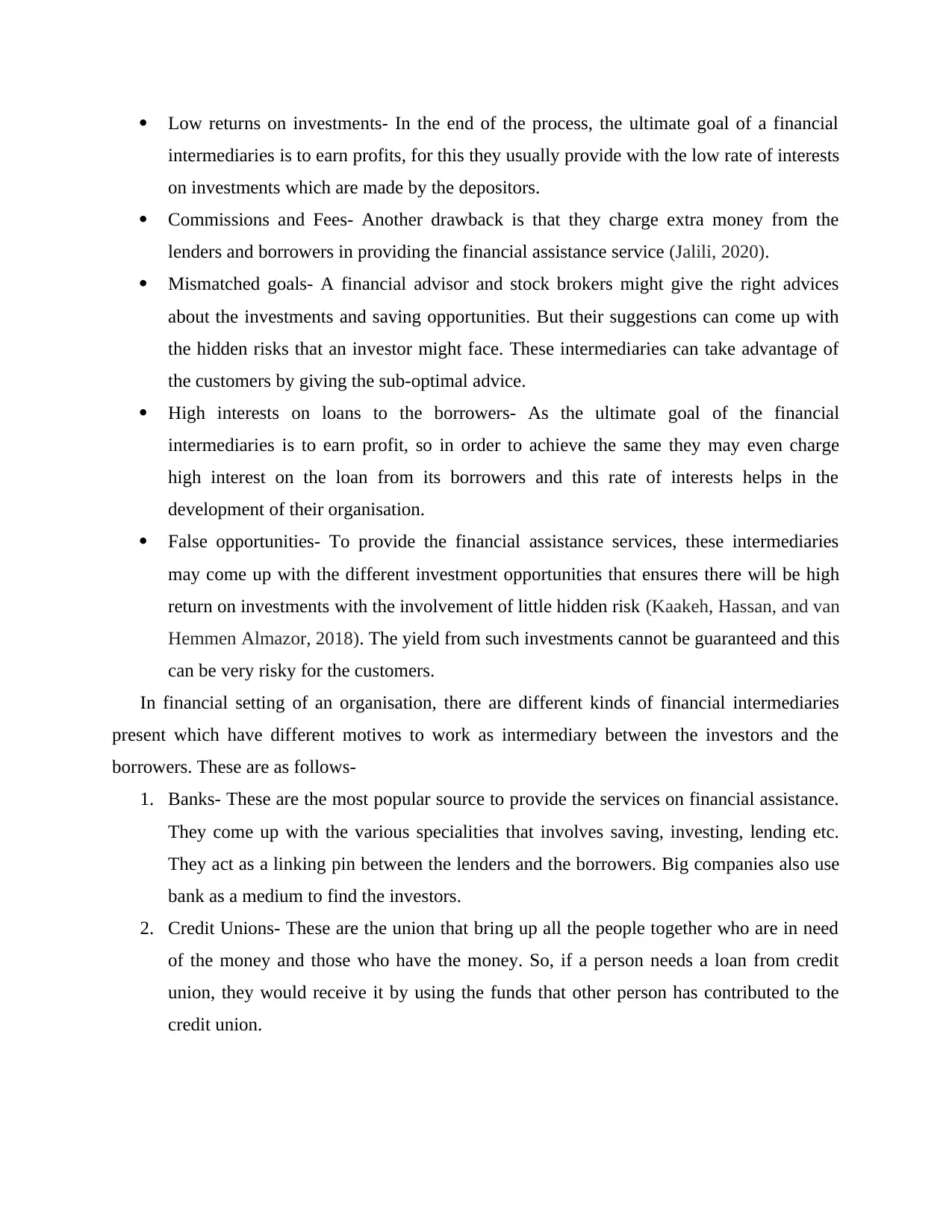
Low returns on investments- In the end of the process, the ultimate goal of a financial
intermediaries is to earn profits, for this they usually provide with the low rate of interests
on investments which are made by the depositors.
Commissions and Fees- Another drawback is that they charge extra money from the
lenders and borrowers in providing the financial assistance service (Jalili, 2020).
Mismatched goals- A financial advisor and stock brokers might give the right advices
about the investments and saving opportunities. But their suggestions can come up with
the hidden risks that an investor might face. These intermediaries can take advantage of
the customers by giving the sub-optimal advice.
High interests on loans to the borrowers- As the ultimate goal of the financial
intermediaries is to earn profit, so in order to achieve the same they may even charge
high interest on the loan from its borrowers and this rate of interests helps in the
development of their organisation.
False opportunities- To provide the financial assistance services, these intermediaries
may come up with the different investment opportunities that ensures there will be high
return on investments with the involvement of little hidden risk (Kaakeh, Hassan, and van
Hemmen Almazor, 2018). The yield from such investments cannot be guaranteed and this
can be very risky for the customers.
In financial setting of an organisation, there are different kinds of financial intermediaries
present which have different motives to work as intermediary between the investors and the
borrowers. These are as follows-
1. Banks- These are the most popular source to provide the services on financial assistance.
They come up with the various specialities that involves saving, investing, lending etc.
They act as a linking pin between the lenders and the borrowers. Big companies also use
bank as a medium to find the investors.
2. Credit Unions- These are the union that bring up all the people together who are in need
of the money and those who have the money. So, if a person needs a loan from credit
union, they would receive it by using the funds that other person has contributed to the
credit union.
intermediaries is to earn profits, for this they usually provide with the low rate of interests
on investments which are made by the depositors.
Commissions and Fees- Another drawback is that they charge extra money from the
lenders and borrowers in providing the financial assistance service (Jalili, 2020).
Mismatched goals- A financial advisor and stock brokers might give the right advices
about the investments and saving opportunities. But their suggestions can come up with
the hidden risks that an investor might face. These intermediaries can take advantage of
the customers by giving the sub-optimal advice.
High interests on loans to the borrowers- As the ultimate goal of the financial
intermediaries is to earn profit, so in order to achieve the same they may even charge
high interest on the loan from its borrowers and this rate of interests helps in the
development of their organisation.
False opportunities- To provide the financial assistance services, these intermediaries
may come up with the different investment opportunities that ensures there will be high
return on investments with the involvement of little hidden risk (Kaakeh, Hassan, and van
Hemmen Almazor, 2018). The yield from such investments cannot be guaranteed and this
can be very risky for the customers.
In financial setting of an organisation, there are different kinds of financial intermediaries
present which have different motives to work as intermediary between the investors and the
borrowers. These are as follows-
1. Banks- These are the most popular source to provide the services on financial assistance.
They come up with the various specialities that involves saving, investing, lending etc.
They act as a linking pin between the lenders and the borrowers. Big companies also use
bank as a medium to find the investors.
2. Credit Unions- These are the union that bring up all the people together who are in need
of the money and those who have the money. So, if a person needs a loan from credit
union, they would receive it by using the funds that other person has contributed to the
credit union.
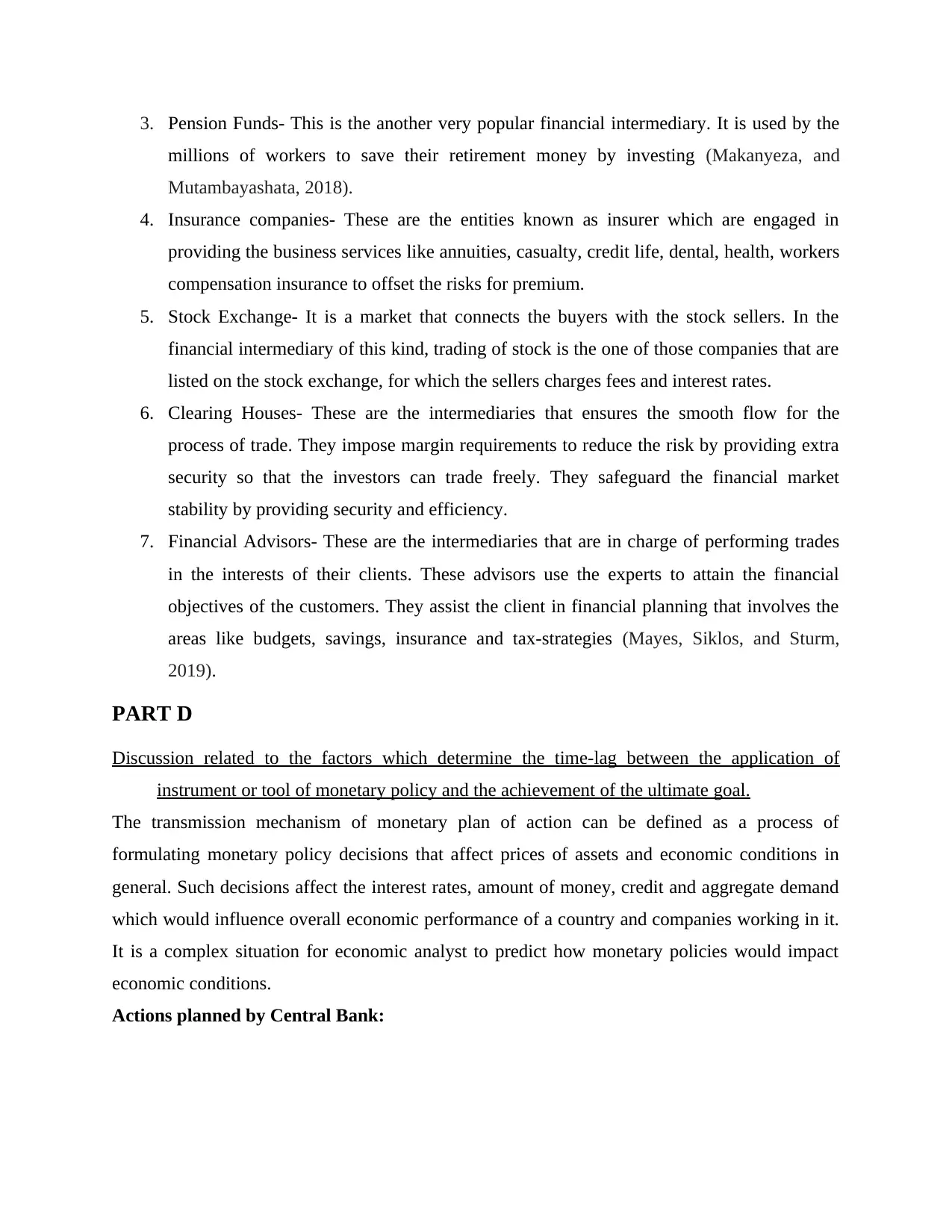
3. Pension Funds- This is the another very popular financial intermediary. It is used by the
millions of workers to save their retirement money by investing (Makanyeza, and
Mutambayashata, 2018).
4. Insurance companies- These are the entities known as insurer which are engaged in
providing the business services like annuities, casualty, credit life, dental, health, workers
compensation insurance to offset the risks for premium.
5. Stock Exchange- It is a market that connects the buyers with the stock sellers. In the
financial intermediary of this kind, trading of stock is the one of those companies that are
listed on the stock exchange, for which the sellers charges fees and interest rates.
6. Clearing Houses- These are the intermediaries that ensures the smooth flow for the
process of trade. They impose margin requirements to reduce the risk by providing extra
security so that the investors can trade freely. They safeguard the financial market
stability by providing security and efficiency.
7. Financial Advisors- These are the intermediaries that are in charge of performing trades
in the interests of their clients. These advisors use the experts to attain the financial
objectives of the customers. They assist the client in financial planning that involves the
areas like budgets, savings, insurance and tax-strategies (Mayes, Siklos, and Sturm,
2019).
PART D
Discussion related to the factors which determine the time-lag between the application of
instrument or tool of monetary policy and the achievement of the ultimate goal.
The transmission mechanism of monetary plan of action can be defined as a process of
formulating monetary policy decisions that affect prices of assets and economic conditions in
general. Such decisions affect the interest rates, amount of money, credit and aggregate demand
which would influence overall economic performance of a country and companies working in it.
It is a complex situation for economic analyst to predict how monetary policies would impact
economic conditions.
Actions planned by Central Bank:
millions of workers to save their retirement money by investing (Makanyeza, and
Mutambayashata, 2018).
4. Insurance companies- These are the entities known as insurer which are engaged in
providing the business services like annuities, casualty, credit life, dental, health, workers
compensation insurance to offset the risks for premium.
5. Stock Exchange- It is a market that connects the buyers with the stock sellers. In the
financial intermediary of this kind, trading of stock is the one of those companies that are
listed on the stock exchange, for which the sellers charges fees and interest rates.
6. Clearing Houses- These are the intermediaries that ensures the smooth flow for the
process of trade. They impose margin requirements to reduce the risk by providing extra
security so that the investors can trade freely. They safeguard the financial market
stability by providing security and efficiency.
7. Financial Advisors- These are the intermediaries that are in charge of performing trades
in the interests of their clients. These advisors use the experts to attain the financial
objectives of the customers. They assist the client in financial planning that involves the
areas like budgets, savings, insurance and tax-strategies (Mayes, Siklos, and Sturm,
2019).
PART D
Discussion related to the factors which determine the time-lag between the application of
instrument or tool of monetary policy and the achievement of the ultimate goal.
The transmission mechanism of monetary plan of action can be defined as a process of
formulating monetary policy decisions that affect prices of assets and economic conditions in
general. Such decisions affect the interest rates, amount of money, credit and aggregate demand
which would influence overall economic performance of a country and companies working in it.
It is a complex situation for economic analyst to predict how monetary policies would impact
economic conditions.
Actions planned by Central Bank:
⊘ This is a preview!⊘
Do you want full access?
Subscribe today to unlock all pages.

Trusted by 1+ million students worldwide
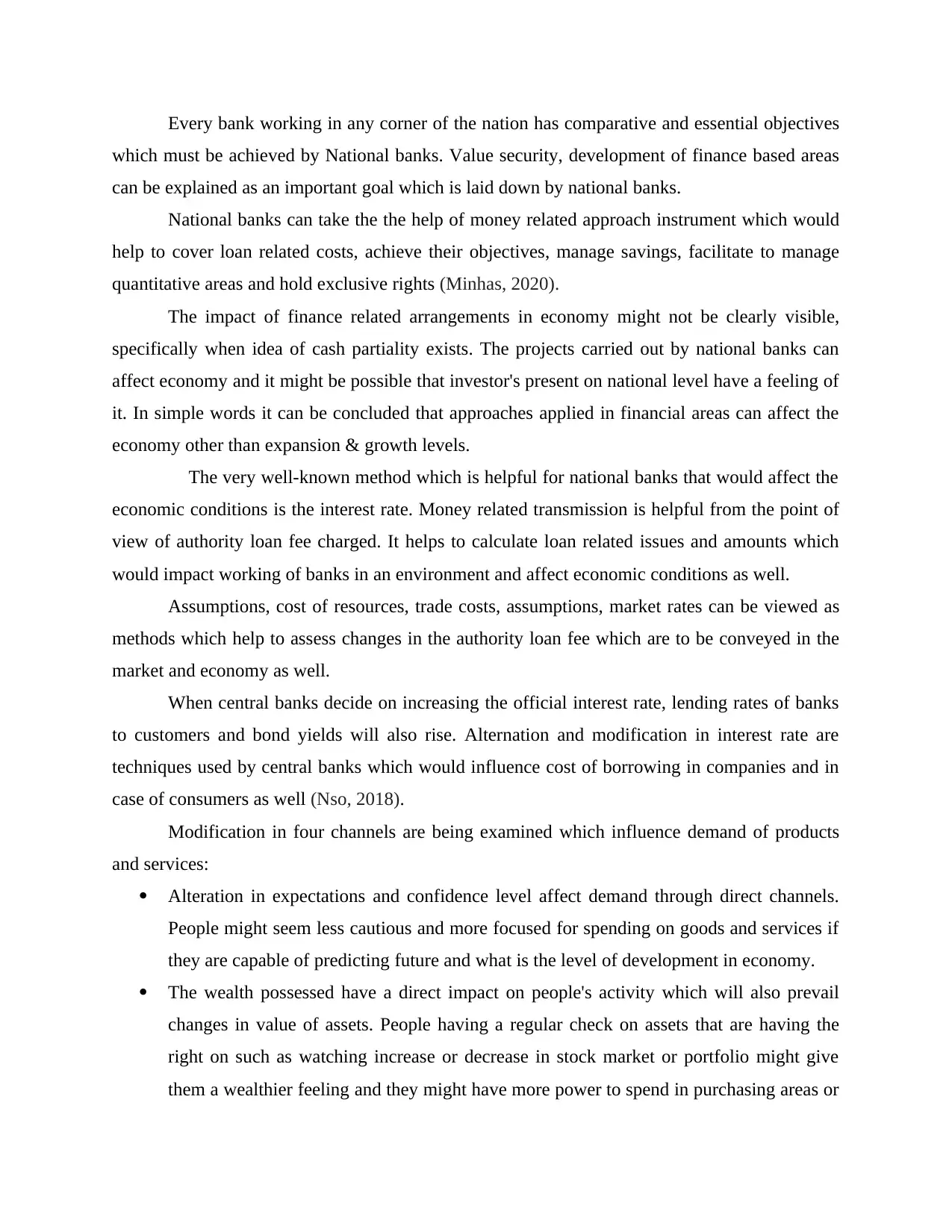
Every bank working in any corner of the nation has comparative and essential objectives
which must be achieved by National banks. Value security, development of finance based areas
can be explained as an important goal which is laid down by national banks.
National banks can take the the help of money related approach instrument which would
help to cover loan related costs, achieve their objectives, manage savings, facilitate to manage
quantitative areas and hold exclusive rights (Minhas, 2020).
The impact of finance related arrangements in economy might not be clearly visible,
specifically when idea of cash partiality exists. The projects carried out by national banks can
affect economy and it might be possible that investor's present on national level have a feeling of
it. In simple words it can be concluded that approaches applied in financial areas can affect the
economy other than expansion & growth levels.
The very well-known method which is helpful for national banks that would affect the
economic conditions is the interest rate. Money related transmission is helpful from the point of
view of authority loan fee charged. It helps to calculate loan related issues and amounts which
would impact working of banks in an environment and affect economic conditions as well.
Assumptions, cost of resources, trade costs, assumptions, market rates can be viewed as
methods which help to assess changes in the authority loan fee which are to be conveyed in the
market and economy as well.
When central banks decide on increasing the official interest rate, lending rates of banks
to customers and bond yields will also rise. Alternation and modification in interest rate are
techniques used by central banks which would influence cost of borrowing in companies and in
case of consumers as well (Nso, 2018).
Modification in four channels are being examined which influence demand of products
and services:
Alteration in expectations and confidence level affect demand through direct channels.
People might seem less cautious and more focused for spending on goods and services if
they are capable of predicting future and what is the level of development in economy.
The wealth possessed have a direct impact on people's activity which will also prevail
changes in value of assets. People having a regular check on assets that are having the
right on such as watching increase or decrease in stock market or portfolio might give
them a wealthier feeling and they might have more power to spend in purchasing areas or
which must be achieved by National banks. Value security, development of finance based areas
can be explained as an important goal which is laid down by national banks.
National banks can take the the help of money related approach instrument which would
help to cover loan related costs, achieve their objectives, manage savings, facilitate to manage
quantitative areas and hold exclusive rights (Minhas, 2020).
The impact of finance related arrangements in economy might not be clearly visible,
specifically when idea of cash partiality exists. The projects carried out by national banks can
affect economy and it might be possible that investor's present on national level have a feeling of
it. In simple words it can be concluded that approaches applied in financial areas can affect the
economy other than expansion & growth levels.
The very well-known method which is helpful for national banks that would affect the
economic conditions is the interest rate. Money related transmission is helpful from the point of
view of authority loan fee charged. It helps to calculate loan related issues and amounts which
would impact working of banks in an environment and affect economic conditions as well.
Assumptions, cost of resources, trade costs, assumptions, market rates can be viewed as
methods which help to assess changes in the authority loan fee which are to be conveyed in the
market and economy as well.
When central banks decide on increasing the official interest rate, lending rates of banks
to customers and bond yields will also rise. Alternation and modification in interest rate are
techniques used by central banks which would influence cost of borrowing in companies and in
case of consumers as well (Nso, 2018).
Modification in four channels are being examined which influence demand of products
and services:
Alteration in expectations and confidence level affect demand through direct channels.
People might seem less cautious and more focused for spending on goods and services if
they are capable of predicting future and what is the level of development in economy.
The wealth possessed have a direct impact on people's activity which will also prevail
changes in value of assets. People having a regular check on assets that are having the
right on such as watching increase or decrease in stock market or portfolio might give
them a wealthier feeling and they might have more power to spend in purchasing areas or
Paraphrase This Document
Need a fresh take? Get an instant paraphrase of this document with our AI Paraphraser
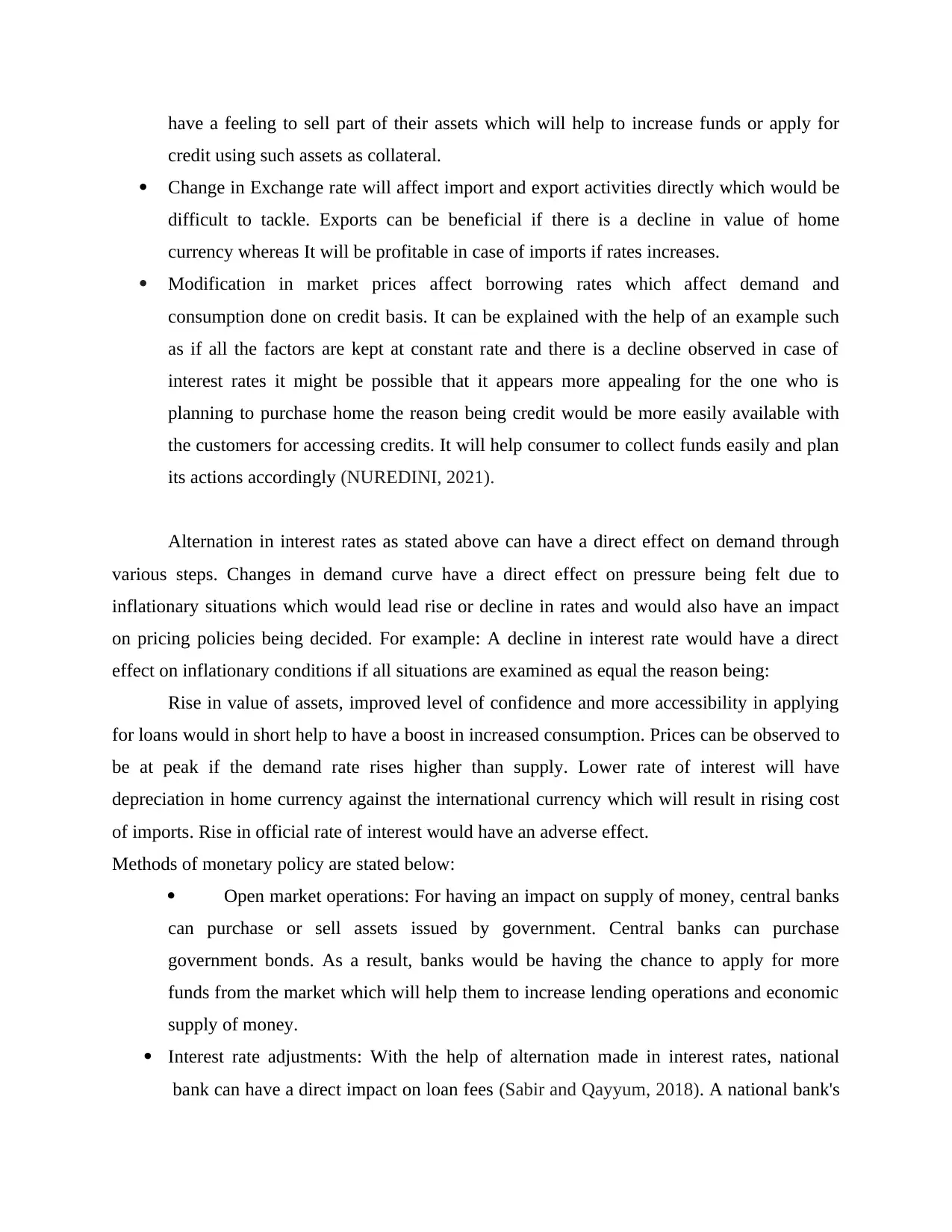
have a feeling to sell part of their assets which will help to increase funds or apply for
credit using such assets as collateral.
Change in Exchange rate will affect import and export activities directly which would be
difficult to tackle. Exports can be beneficial if there is a decline in value of home
currency whereas It will be profitable in case of imports if rates increases.
Modification in market prices affect borrowing rates which affect demand and
consumption done on credit basis. It can be explained with the help of an example such
as if all the factors are kept at constant rate and there is a decline observed in case of
interest rates it might be possible that it appears more appealing for the one who is
planning to purchase home the reason being credit would be more easily available with
the customers for accessing credits. It will help consumer to collect funds easily and plan
its actions accordingly (NUREDINI, 2021).
Alternation in interest rates as stated above can have a direct effect on demand through
various steps. Changes in demand curve have a direct effect on pressure being felt due to
inflationary situations which would lead rise or decline in rates and would also have an impact
on pricing policies being decided. For example: A decline in interest rate would have a direct
effect on inflationary conditions if all situations are examined as equal the reason being:
Rise in value of assets, improved level of confidence and more accessibility in applying
for loans would in short help to have a boost in increased consumption. Prices can be observed to
be at peak if the demand rate rises higher than supply. Lower rate of interest will have
depreciation in home currency against the international currency which will result in rising cost
of imports. Rise in official rate of interest would have an adverse effect.
Methods of monetary policy are stated below:
Open market operations: For having an impact on supply of money, central banks
can purchase or sell assets issued by government. Central banks can purchase
government bonds. As a result, banks would be having the chance to apply for more
funds from the market which will help them to increase lending operations and economic
supply of money.
Interest rate adjustments: With the help of alternation made in interest rates, national
bank can have a direct impact on loan fees (Sabir and Qayyum, 2018). A national bank's
credit using such assets as collateral.
Change in Exchange rate will affect import and export activities directly which would be
difficult to tackle. Exports can be beneficial if there is a decline in value of home
currency whereas It will be profitable in case of imports if rates increases.
Modification in market prices affect borrowing rates which affect demand and
consumption done on credit basis. It can be explained with the help of an example such
as if all the factors are kept at constant rate and there is a decline observed in case of
interest rates it might be possible that it appears more appealing for the one who is
planning to purchase home the reason being credit would be more easily available with
the customers for accessing credits. It will help consumer to collect funds easily and plan
its actions accordingly (NUREDINI, 2021).
Alternation in interest rates as stated above can have a direct effect on demand through
various steps. Changes in demand curve have a direct effect on pressure being felt due to
inflationary situations which would lead rise or decline in rates and would also have an impact
on pricing policies being decided. For example: A decline in interest rate would have a direct
effect on inflationary conditions if all situations are examined as equal the reason being:
Rise in value of assets, improved level of confidence and more accessibility in applying
for loans would in short help to have a boost in increased consumption. Prices can be observed to
be at peak if the demand rate rises higher than supply. Lower rate of interest will have
depreciation in home currency against the international currency which will result in rising cost
of imports. Rise in official rate of interest would have an adverse effect.
Methods of monetary policy are stated below:
Open market operations: For having an impact on supply of money, central banks
can purchase or sell assets issued by government. Central banks can purchase
government bonds. As a result, banks would be having the chance to apply for more
funds from the market which will help them to increase lending operations and economic
supply of money.
Interest rate adjustments: With the help of alternation made in interest rates, national
bank can have a direct impact on loan fees (Sabir and Qayyum, 2018). A national bank's
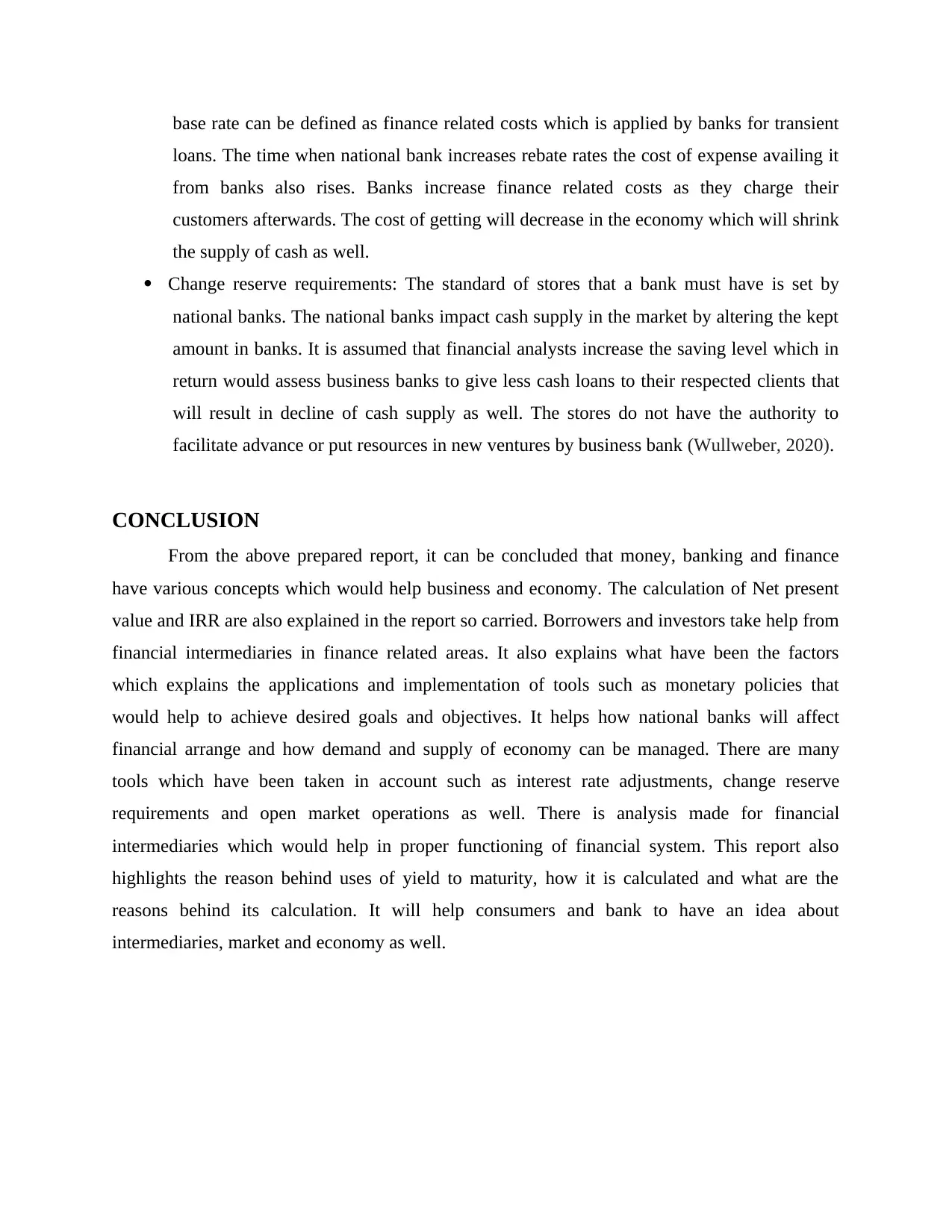
base rate can be defined as finance related costs which is applied by banks for transient
loans. The time when national bank increases rebate rates the cost of expense availing it
from banks also rises. Banks increase finance related costs as they charge their
customers afterwards. The cost of getting will decrease in the economy which will shrink
the supply of cash as well.
Change reserve requirements: The standard of stores that a bank must have is set by
national banks. The national banks impact cash supply in the market by altering the kept
amount in banks. It is assumed that financial analysts increase the saving level which in
return would assess business banks to give less cash loans to their respected clients that
will result in decline of cash supply as well. The stores do not have the authority to
facilitate advance or put resources in new ventures by business bank (Wullweber, 2020).
CONCLUSION
From the above prepared report, it can be concluded that money, banking and finance
have various concepts which would help business and economy. The calculation of Net present
value and IRR are also explained in the report so carried. Borrowers and investors take help from
financial intermediaries in finance related areas. It also explains what have been the factors
which explains the applications and implementation of tools such as monetary policies that
would help to achieve desired goals and objectives. It helps how national banks will affect
financial arrange and how demand and supply of economy can be managed. There are many
tools which have been taken in account such as interest rate adjustments, change reserve
requirements and open market operations as well. There is analysis made for financial
intermediaries which would help in proper functioning of financial system. This report also
highlights the reason behind uses of yield to maturity, how it is calculated and what are the
reasons behind its calculation. It will help consumers and bank to have an idea about
intermediaries, market and economy as well.
loans. The time when national bank increases rebate rates the cost of expense availing it
from banks also rises. Banks increase finance related costs as they charge their
customers afterwards. The cost of getting will decrease in the economy which will shrink
the supply of cash as well.
Change reserve requirements: The standard of stores that a bank must have is set by
national banks. The national banks impact cash supply in the market by altering the kept
amount in banks. It is assumed that financial analysts increase the saving level which in
return would assess business banks to give less cash loans to their respected clients that
will result in decline of cash supply as well. The stores do not have the authority to
facilitate advance or put resources in new ventures by business bank (Wullweber, 2020).
CONCLUSION
From the above prepared report, it can be concluded that money, banking and finance
have various concepts which would help business and economy. The calculation of Net present
value and IRR are also explained in the report so carried. Borrowers and investors take help from
financial intermediaries in finance related areas. It also explains what have been the factors
which explains the applications and implementation of tools such as monetary policies that
would help to achieve desired goals and objectives. It helps how national banks will affect
financial arrange and how demand and supply of economy can be managed. There are many
tools which have been taken in account such as interest rate adjustments, change reserve
requirements and open market operations as well. There is analysis made for financial
intermediaries which would help in proper functioning of financial system. This report also
highlights the reason behind uses of yield to maturity, how it is calculated and what are the
reasons behind its calculation. It will help consumers and bank to have an idea about
intermediaries, market and economy as well.
⊘ This is a preview!⊘
Do you want full access?
Subscribe today to unlock all pages.

Trusted by 1+ million students worldwide

Paraphrase This Document
Need a fresh take? Get an instant paraphrase of this document with our AI Paraphraser

REFERENCES
Books and Journals
Abbas, F., Iqbal, S. and Aziz, B., 2020. The role of bank liquidity and bank risk in determining
bank capital: Empirical analysis of asian banking industry. Review of Pacific Basin Financial
Markets and Policies, 23(03), p.2050020.
Alami, I., 2019. Money power and financial capital in emerging markets: Facing the liquidity
tsunami. Routledge.
Borini, R., 2018. More Banking for Less Money. The WealthTech Book: The FinTech Handbook
for Investors, Entrepreneurs and Finance Visionaries, pp.273-274.
Cao, J., 2021. The Economics of Banking. Routledge.
Chazi, A., Mirzaei, A., and Azad, A.S., 2020. Does the size of Islamic banking matter for
industry growth: international evidence? Applied Economics, 52(4), pp.361-374.
Chen, K., 2018. Financial innovation and technology firms: A smart new world with machines.
In Banking and finance issues in emerging markets. Emerald Publishing Limited.
Golubic, G., 2019. Do Digital Technologies Have the Power to Disrupt Commercial
Banking. InterEULawEast: J. Int'l & Eur. L., Econ. & Market Integrations, 6, p.83.
Jalili, R., 2020. The Essentials of Islamic Banking, Finance, and Capital Markets by John
Oluseyi Kuforiji. Journal of Global South Studies, 37(2), pp.376-379.
Kaakeh, A., Hassan, M.K. and van Hemmen Almazor, S.F., 2018. Attitude of Muslim minority
in Spain towards Islamic finance. International Journal of Islamic and Middle Eastern
Finance and Management.
Makanyeza, C. and Mutambayashata, S., 2018. Consumers’ acceptance and use of plastic money
in Harare, Zimbabwe: Application of the unified theory of acceptance and use of
technology 2. International Journal of Bank Marketing.
Mayes, D.G., Siklos, P.L. and Sturm, J.E., 2019. The Oxford handbook of the economics of
central banking. Oxford Handbooks.
Minhas, I.H., 2020. Shariah Compliant Model of Islamic Banking. Journal of Islamic Banking &
Finance, 37(3).
Nso, M.A., 2018. Impact of Technology on E-Banking; Cameroon Perspectives. International
Journal of Advanced Networking and Applications, 9(6), pp.3645-3653.
NUREDINI, B., 2021. LEGAL ASPECTS OF INTEREST IN ISLAMIC VS.
CONVENTIONAL BANKING. Vizione, (36).
Sabir, S. and Qayyum, A., 2018. Competition in the Banking Sector of Pakistan: Evidence from
Unscaled and Scaled Revenue Equations1. Journal of Economic Cooperation &
Development, 39(1), pp.19-37.
Wullweber, J., 2020. Embedded finance: the shadow banking system, sovereign power, and a
new state–market hybridity. Journal of Cultural Economy, 13(5), pp.592-609.
Zhao, Y., Chupradit, S., and Khader, J., 2021. The role of technical efficiency, market
competition and risk in the banking performance in G20 countries. Business Process
Management Journal.
Books and Journals
Abbas, F., Iqbal, S. and Aziz, B., 2020. The role of bank liquidity and bank risk in determining
bank capital: Empirical analysis of asian banking industry. Review of Pacific Basin Financial
Markets and Policies, 23(03), p.2050020.
Alami, I., 2019. Money power and financial capital in emerging markets: Facing the liquidity
tsunami. Routledge.
Borini, R., 2018. More Banking for Less Money. The WealthTech Book: The FinTech Handbook
for Investors, Entrepreneurs and Finance Visionaries, pp.273-274.
Cao, J., 2021. The Economics of Banking. Routledge.
Chazi, A., Mirzaei, A., and Azad, A.S., 2020. Does the size of Islamic banking matter for
industry growth: international evidence? Applied Economics, 52(4), pp.361-374.
Chen, K., 2018. Financial innovation and technology firms: A smart new world with machines.
In Banking and finance issues in emerging markets. Emerald Publishing Limited.
Golubic, G., 2019. Do Digital Technologies Have the Power to Disrupt Commercial
Banking. InterEULawEast: J. Int'l & Eur. L., Econ. & Market Integrations, 6, p.83.
Jalili, R., 2020. The Essentials of Islamic Banking, Finance, and Capital Markets by John
Oluseyi Kuforiji. Journal of Global South Studies, 37(2), pp.376-379.
Kaakeh, A., Hassan, M.K. and van Hemmen Almazor, S.F., 2018. Attitude of Muslim minority
in Spain towards Islamic finance. International Journal of Islamic and Middle Eastern
Finance and Management.
Makanyeza, C. and Mutambayashata, S., 2018. Consumers’ acceptance and use of plastic money
in Harare, Zimbabwe: Application of the unified theory of acceptance and use of
technology 2. International Journal of Bank Marketing.
Mayes, D.G., Siklos, P.L. and Sturm, J.E., 2019. The Oxford handbook of the economics of
central banking. Oxford Handbooks.
Minhas, I.H., 2020. Shariah Compliant Model of Islamic Banking. Journal of Islamic Banking &
Finance, 37(3).
Nso, M.A., 2018. Impact of Technology on E-Banking; Cameroon Perspectives. International
Journal of Advanced Networking and Applications, 9(6), pp.3645-3653.
NUREDINI, B., 2021. LEGAL ASPECTS OF INTEREST IN ISLAMIC VS.
CONVENTIONAL BANKING. Vizione, (36).
Sabir, S. and Qayyum, A., 2018. Competition in the Banking Sector of Pakistan: Evidence from
Unscaled and Scaled Revenue Equations1. Journal of Economic Cooperation &
Development, 39(1), pp.19-37.
Wullweber, J., 2020. Embedded finance: the shadow banking system, sovereign power, and a
new state–market hybridity. Journal of Cultural Economy, 13(5), pp.592-609.
Zhao, Y., Chupradit, S., and Khader, J., 2021. The role of technical efficiency, market
competition and risk in the banking performance in G20 countries. Business Process
Management Journal.
1 out of 14
Related Documents
Your All-in-One AI-Powered Toolkit for Academic Success.
+13062052269
info@desklib.com
Available 24*7 on WhatsApp / Email
![[object Object]](/_next/static/media/star-bottom.7253800d.svg)
Unlock your academic potential
© 2024 | Zucol Services PVT LTD | All rights reserved.




